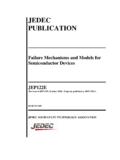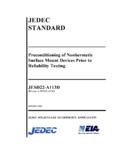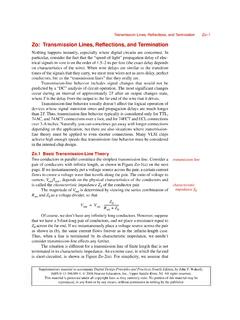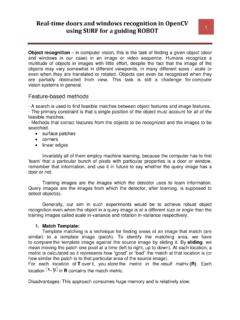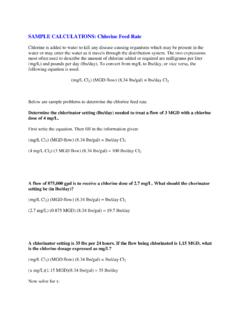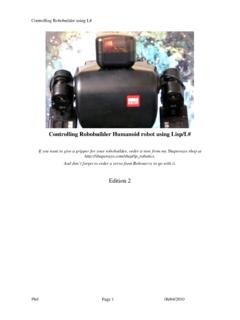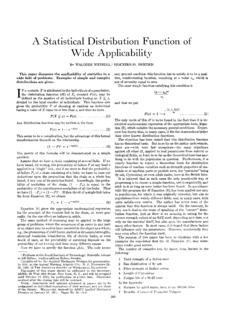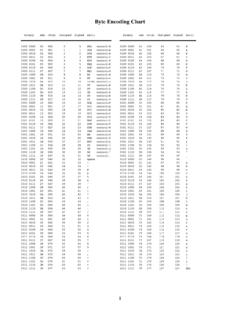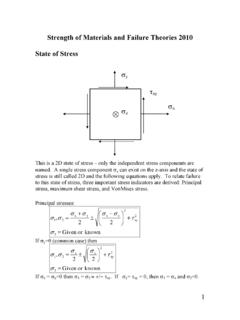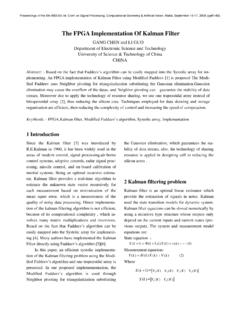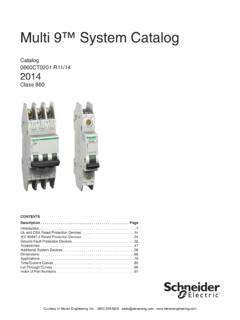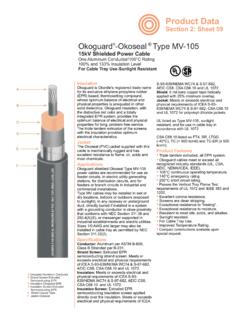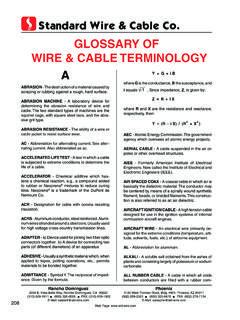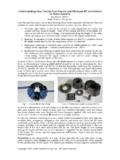Transcription of Conversion of Thermocouple Voltage to Temperature
1 Conversion of Thermocouple Voltageto TemperatureGerald Recktenwald February 27, 2020 AbstractThis article provides a practical introduction to the Conversion of ther-mocouple Voltage to Temperature . Beginning with a description of theSeebeck effect, the basic equations relating EMF and Temperature arepresented. A few of the more practical Thermocouple circuits are ana-lyzed, Temperature measurement with a basic ice-point reference circuitis described, and computational formulas for data reduction are of a zone box with a floating reference junction Temperature is OverviewThermocouples are inexpensive and versatile devices for measuring can be purchased in many different prefabricated basic laboratory work, thermocouples can be easily fabricated from bulkthermocouple wire.
2 The proper fabrication and installation of thermocouplesis not discussed here. This document provides the necessary background andcomputational procedures for Conversion of Voltage measurements from thermo-couples fabricated in the lab, or purchased from a measurement devices range from hand-held units to multi-channel data acquisition systems. Since thermocouples can only indicate tem-perature differences, a reference junction is required to make an absolute tem-perature measurement. Turnkey Thermocouple systems include a method fortemperature compensation for the reference junction. The correct data con-version procedure for a reference junction at an arbitrary Temperature is notdifficult.
3 Unfortunately the steps in this process do not appear to be goal of this document is to equip the reader with the knowledge and cal-culation procedures for converting raw Thermocouple Voltage readings to temper-ature. Readers wishing to use turnkey systems will benefit from understandingthe process of data Conversion . In particular, the reader will see that one reason Mechanical and Materials Engineering Department, Portland State University, This material is Copyrightc 2001 2020, Gerald W. Recktenwald, all rights is hereby granted for distribution of this document for non-commercial educationalpurposesso long asthis document is retained intact, and proper attribution is PHYSICS OF THERMOCOUPLES2for uncertainties associated with Thermocouple Temperature measurement is thelack of control over the reference junction Temperature in turnkey systems.
4 Itis easy to construct a zone box that maintains the reference junction(s) at auniform Temperature , and thereby achieve more accurate Temperature measure-ment than is possible with most turnkey Physics of ThermocouplesThe equations necessary for the practical use of thermocouples are derived fromthe basic definition of the Seebeck Effect. This information is extracted fromChapter 2 ofA Manual on the Use of Thermocouples in Temperature Measure-mentby the American Society for Testing and Materials [1]. Anyone usingthermocouples would benefit from studying the ASTM The Seebeck EffectElectrically conductive materials exhibit three types of thermoelectric phenom-ena: the Seebeck effect, the Thompson effect, and the Peltier effect.
5 The Seebeckeffect is manifest as a Voltage potential that occurs when there is a temperaturegradient along the length of a conductor . This Temperature -induced electricalpotential is called anelectromotive forceand abbreviated as macroscopic manifestation of EMF is due to the rearrangement of thefree electrons in the conductor . When the Temperature and all other envi-ronmental variables that might affect the wire are uniform, the most probabledistribution of the free electrons is uniform. The presence of a temperaturegradient causes a redistribution of the free electrons, which results in a non-uniform distribution of the electric charge on the conductor . Above submicronlength scales, the charge distribution does not depend on the geometry, shape or length, of the conductor .
6 As a practical consequence ofthe charge distribution, the conductor exhibits a variation of Voltage potential(the EMF) that is directly related to the Temperature gradient imposed on theconductor. Because the EMF is uniquely related to the temperaturegradient,the Seebeck effect can be used to measure 1 represents a conceptual experiment that exhibits the Seebeck two ends of a conducting wire are held at two different temperaturesT1andT2. For clarity, assume thatT2> T1, although with appropriate changes ofsign, the development that follows is also applicable to the case whereT2< the probes of an ideal voltmeter could be connected to the two ends of thewire without disturbing the Temperature or Voltage potential of the wire, thevoltmeter would indicate a Voltage difference on the order of 10 5volts perdegree Celsius of Temperature difference.
7 The relationship between the EMFand the Temperature difference can be represented asE12= (T2 T1)(1)where is the averageSeebeck coefficientfor the wire material over the tem-perature rangeT1 T voltmeter in Figure 1 is imaginary because the copper leads of thevoltmeter probe also exhibit the Seebeck effect. If the leads of the voltmeter2 PHYSICS OF THERMOCOUPLES3T1T2 VoltmeterE12 Figure 1: A conceptual experiment to exhibit the Seebeck effect in a wire withend temperaturesT1andT2. The dashed boxes represent local environments atuniform temperatures. The open circles are the ends of the measuring probes ofthe ideal voltmeter that can detect the Voltage potentialE12without actuallytouching the ends of the wire.
8 The solid circles are the ends of the connected to the wire, the Voltage indicated by the voltmeter would bethe combined potential due to the Seebeck effect in the wire sample and theSeebeck effect in the probe leads. Thus, the circuit in Figure 1 is not practicalfor measuring Seebeck coefficient is a property of the wire material. The value of does not depend on the length, diameter, or any other geometrical feature of theconductor wire. On the other hand, the Seebeck coefficient of a given materialcanbe effected by oxidation or reduction of the conductor material, or by plasticstrain of the general, the Seebeck coefficient is a function of Temperature . To developa more precise and versatile relationship than Equation (1), consider an exper-iment whereT1is fixed, andT2is varied.
9 For practical Thermocouple materialsthe relationship betweenEandTis continuous. Hence, for sufficiently smallchange T2inT2, the EMF indicated by the voltmeter will change by a corre-sponding small amount E12. Since T2and E12are small, it is reasonableto linearize the EMF response asE12+ E12= (T2 T1) + (T2) T2(2)where (T2) is the value of the Seebeck coefficient atT2. The change in EMFonly depends on the value of the Seebeck coefficient atT2becauseT1is heldfixed. Subtract Equation (1) from Equation (2) to get E12= (T2) T2(3)which can be rearranged as (T2) = E12 T2(4)If is an intrinsic property of the material, then the preceding equation musthold for any Temperature . Replacing all references toT2with an arbitrarytemperatureT, and taking the limit as the Temperature perturbation goes tozero, gives (T) = lim T 0 E T(5)2 PHYSICS OF THERMOCOUPLES4 TtTjVoltmetermaterial Amaterial BxFigure 2: A simple the Fundamental Theorem of Calculus, the limit becomes a result is the generaldefinition of the Seebeck Coefficient (T) =dEdT(6)Equation (6) contains all the theoretical information necessary to analyze ther-mocouple EMF Relationships for ThermocouplesThe wire depicted in Figure 1 is not directly useful for measuring the situation in Figure 1, the voltmeter probes also experience a temperaturegradient.
10 The probes are made of Copper wire, and Copper has a Seebeckcoefficient comparable with other metals used to make thermocouples. Thus,unless both ends of each probe wire are at the same Temperature , the probesthemselves will contribute an additional EMF to the circuit. In other words,although one might imagine the measurement of the EMF for a single wire, itis not feasible to do so in exploitation of the Seebeck effect to measure Temperature requiresa combination of two wires with dissimilar Seebeck coefficients. The namethermocouplereflects the reality that wires with two different compositions arecombined to form a Thermocouple circuit. Figure 2 represents such a basicthermocouple.
